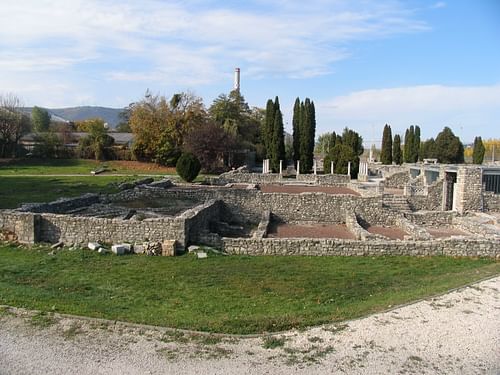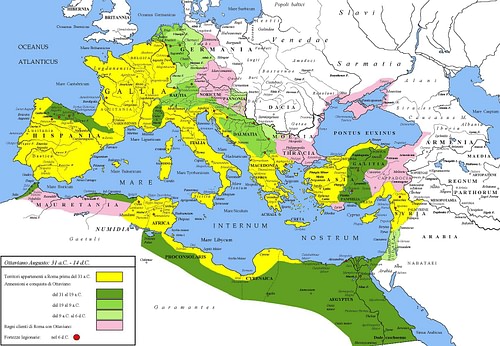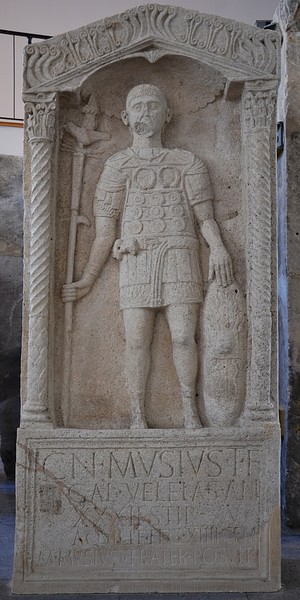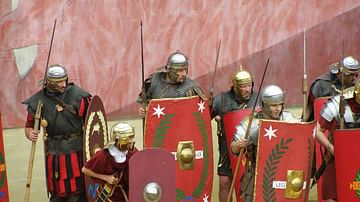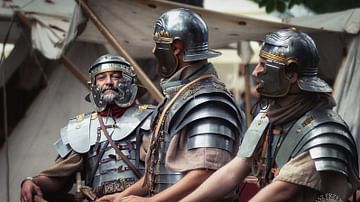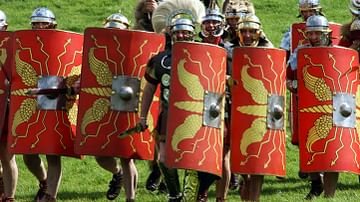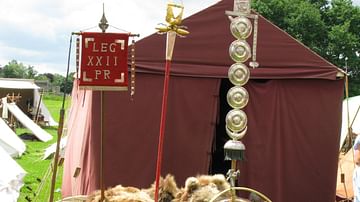Located west of the Danube, Pannonia was essential for the protection of the Roman Empire's eastern frontier. It had been occupied since 9 BCE but did not willingly accept Roman authority. Pannonia and Dalmatia revolted in 6 CE, and it would take three years and a total of eleven legions to finally bring Roman victory in 9 CE. To ensure peace, four legions were assigned to Pannonia: X Gemina, XIV Gemina, I Adiutrix, and II Adiutrix.
The Pannonian Revolt
After years of conflict with Rome, Pannonia had finally fallen under Roman control in 9 BCE. The uneasy peace that followed would not last long. After the Roman commander and future emperor Tiberius (r. 14-37 CE) withdrew legions from Pannonia and Dalmatia for his Germanic campaign in 5 CE, the two provinces seized the opportunity to rise up and revolt. The Pannonian rebel army struck first, marching into Macedonia. Meanwhile, Dalmatian rebels began to raid neighboring towns, attacking Roman auxiliaries and massacring Roman citizens. With this initial success, more and more Dalmatians joined in the cause. Eventually, the rebels would number over 200,000 – one-fourth of their combined population. Although surrounded by the rebellious army, the governor of Dalmatia, Marcus Messalinus, and cohorts of the 20th legion were able to rout the rebels. After the Pannonians laid siege to Sirmium (in modern Serbia), the governor of Moesia, Caecina Severus, and his legions marched westward to meet the Pannonian commander and his army and defeated him.
With the Dalmatian attack on Salonae (in modern Croatia) and much of the Adriatic coast in rebel control, panic across Italy forced the Roman emperor Augustus (r. 27 BCE - 14 CE) to recall Tiberius. With Legio VIII Augusta, Legio XI Hispana, Legio XIV Gemina Martia Victrix, Legio XV Apollinaris, and cohorts of the Legio XX, he marched into the rebelling provinces. In addition to Tiberius, Augustus sent the young Germanicus (15 BCE - 19 CE) to the Balkans with a force of evocati and non-citizen troops. Meanwhile, Aulus Caecina Severus and Plautius Silvanus arrived from the East with five legions. In total, the Roman army numbered 10 legions, 70 cohorts of auxiliary, 14 cavalry wings, and 10,000 evocati.
The Pannonians abandoned their plan to march on Rome, and the Dalmatian commander grew suspicious of his counterpart's loyalty to the cause. The Pannonian leader was captured, put on trial, found guilty, and executed. After this, the Roman army laid siege to several Dalmatian towns. Casualties were high on both sides, and it took one-third of the Roman army to finally suppress the uprising. Before the Dalmatian commander was led off to live the remainder of his life in house arrest, he had one final comment, blaming Rome for the war: "We are your flocks, yet you didn’t send shepherds to look after us, you sent wolves." (quoted in Dando-Collins, 234) Writing years later, the historian Suetonius (c. 69 - c. 130/140 CE) wrote in his biography of Tiberius about the seriousness of the rebellion. He said the revolt "proved to be the most bitterly fought of all foreign wars since Rome had defeated Carthage" (Twelve Caesars, 114).
In his The Complete Roman Legions, historian Nigel Pollard places four legions permanently in Pannonia:
- Legio X Gemina
- Legio XIV Gemina
- Legio I Adiutrix
- Legio II Adiutrix
Legio X Gemina
The origin of Legio X Gemina (emblem: bull; birth sign: Capricorn) is unclear. Since early legions were known by a number and not a name, some historians believe X Gemina is the same 10th legion that served with Julius Caesar (100-44 BCE) in Gaul and later against Pompey the Great (106-48 BCE) in the Civil Wars. It may have fought at the Battle of Pharsalus in 48 BCE, at the Battle of Thapsus in 46 BCE, and at the Battle of Munda in 45 BCE. The legion was supposedly disbanded only to be reconstituted, fighting against Caesar's assassins at Phillippi in 42 BCE and with Mark Antony (83-30 BCE) in his Parthian campaign. A 10th legion was part of Antony’s army that suffered defeat by Octavian (the future Augustus) at the Battle of Actium in 31 BCE. According to Suetonius, Octavian "gave the entire Tenth Legion an ignominious discharge because of their insolent behaviour…" (55) The legion was later reformed by Augustus from the merger of two legions, hence the title 'Gemina'.
Arriving in Spain in 30 BCE, Legio X Gemina served under Octavian in his Cantabrian campaign. Afterwards, it was based in Petavonium (in Spain). In the early 60s CE, the legion was transferred along with the XIV Gemina Martia Victrix to Carnuntum (in modern-day Austria), preparing for Nero's (r. 54-68 CE) aborted invasion of Parthia. However, with the outbreak of the Great Jewish Revolt of 66 CE, the 10th legion returned to Spain. Although it had declared for the governor of Germania Inferior, Vitellius, against Otho in 69 CE, it did not participate in the Battle of Bedriacum or in his march on Rome. In 70 CE, it was relocated to the Rhine to assist Petillius Cerialis' campaign to suppress the Batavian Revolt of Julius Civilis, fighting at the Battle of Vetera (Old Camp, modern-day Xanten, Germany). Afterwards, it was stationed at Ulpia Noviomagus (modern Nijmegen, the Netherlands). A decade later, it was part of the force that defeated the governor Lucius Saturninus' revolt against Rome.
Returning to Pannonia at Aquincum (modern Budapest, Hungary) in 101 CE, it reportedly participated in both of Trajan's (r. 98-117 CE) Dacian Wars and possibly in his Parthian campaign. It was then transferred to Vindobona (modern Vienna, Austria). Later, it served under Lucius Verus (r. 161-169 CE) in a battle against the Parthians and under Marcus Aurelius (r. 161-180 CE) in his war with against the Marcomanni. Legio X Gemina supported Septimius Severus' (r. 193-211 CE) claim to the Roman throne and fought under him against the claimant Pescennius Niger. Although sources vary, it seems that in the 3rd century CE, the legion was with Emperor Aurelian (r. 270-275 CE) when he defeated Queen Zenobia. The legion would remain at Vindobona for the remainder of its existence.
Legio XIV Gemina Martia Victrix
The Legio XIV Gemina Martia Victrix (emblem: eagle wings and thunderbolts; birth sign: Capricorn) was originally formed by Julius Caesar around 57 BCE. It was destroyed in his campaign against the Belgae only to be reformed, serving with Caesar in the Civil Wars and at Thapsus in 46 BCE. Although sources are unclear, the 14th legion may have been with Octavian at Actium in 31 BCE. Like the 10th, it was again reformed and combined with another legion. Initially part of Tiberius' campaign against the Marcomanni, it was with the commander in Parthia, too. Afterwards, it was transferred to Germania Superior (Upper Germany), sharing a base with Legio XVI Gallica.
The 14th was one of the legions sent by Claudius (r. 41-54 CE) to Britain in 43 CE where it helped defeat the forces of Boudicca in 60-61 CE. Some sources believe it received the title 'Martia Victrix' ("warlike and victorious") from Nero because of its achievements in Roman Britain, and Tacitus referred to the legion as the "Conqueror of Britain". In 68 CE, the legion was transferred out of Britain to serve with Nero in his aborted eastern campaign. After Nero's death, the 14th supported Otho but failed to arrive in time to be of any assistance at Bedriacum. Vitellius (r. 69 CE) sent the legion back to Britain. Returning to the continent, along with other legions of the Rhine frontier, Legio XIV helped suppress the Batavian Revolt. Transferred to Moguntiacum (modern Mainz, Germany), it shared a base with Legio XXI Rapax. After supporting the Saturninus in his revolt, the legion was sent to Pannonia where it was based at Vindobona, campaigning against the Suebians and Sarmatians in 92-93 CE. Later, it fought under Trajan in the Dacian Wars. Based at Carnuntum for the remainder of its existence, it served with both Lucius Verus and Marcus Aurelius.
Legio I Adiutrix
The formation of Legio I Adiutrix (emblem: Pegasus; birth sign: Capricorn) is steeped in controversy. It was formed either by Nero or Galba from sailors of the Misenum fleet. Failing to receive their commission from Nero, the soldiers took their appeal to the new emperor Galba. As he marched into Rome, an angrier-than-usual Galba refused their request and ordered his personal guard to turn on the would-be legionaries at the Milvian Bridge. With a number of them murdered and others imprisoned, the future of the legion seemed improbable. Appealing to Otho when he challenged Galba for the throne, there seemed to be a possibility. Belatedly, Galba commissioned the I Adiutrix, hoping it would support him against Otho. However, the new legion declared for Otho instead of Galba. Upon taking the throne, Otho filled the I Adiutrix with the remaining survivors of the Milvian Bridge massacre.
Having been sailors, the legion chose Pegasus, son of the Roman sea god Neptune, as its emblem. At the First Battle of Bedriacum, Otho was defeated by Vitellius, and the new emperor sent the I Adiutrix to Spain. When Vitellius was challenged for the throne, I Adiutrix supported Vespasian (r. 69-79 CE); its treatment by Vitellius after the first Bedriacum was still fresh in its memory. The relatively new legion demonstrated valor as it faced far more experienced legions. In 70 CE, Vespasian sent the legion to Moguntiacum where it shared a base with XIV Gemina.
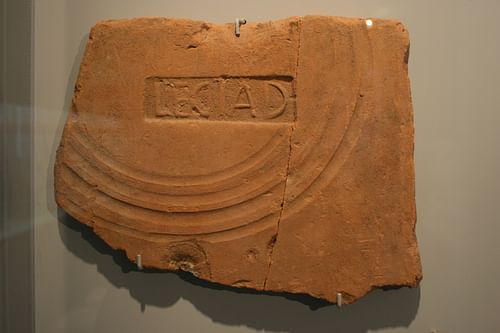
Later, the legion was transferred to Brigetio (modern Komárom, Hungary) in Pannonia. The legion participated in Domitian's (r. 81-96 CE) campaign against the Dacians in 88 CE at the Battle of Tapae. Although four legions were stationed in Moesia at the time of Trajan's march into Dacia to encounter Decebalus, the I Adiutrix, along with the XIV Gemina, XV Apollinaris, X Gemina, and II Adiutrix, joined him. Some of the legions of the Dacian Wars followed Trajan to fight beside him in his Parthian campaign of 116-117 CE. Trajan's successor, Hadrian (r. 117-138 CE), transferred the legion to the Danube where it would fight with Marcus Aurelius in his German campaign.
Legio XIV Gemina supported Septimius Severus in his march on Rome to be declared emperor. It served with him against the claimant Pescennius Niger and later in his Parthian campaign. In 238 CE, the legion fought with Emperor Maximinus Thrax (r. 235-238 CE) at his siege of Aquileia in northern Italy. After supporting Gordian III (r. 238-244 CE) against the Persians, the legion would spend the remainder of its existence at Brigetio.
Legio II Adiutrix
Like its sister legion, I Adiutrix, Legio II Adiutrix (emblem: Pegasus; birth sign: Capricorn) was formed from sailors from the Roman navy's fleet of Ravenna, in either 69 or 70 CE. While this fact is accepted, the question most often asked is who formed it. Some historians maintain the legion probably existed at least one year before Vespasian defeated Vitellius. To confirm this belief, historians cite a passage from Tacitus' History which alludes to a number of legions belonging to Vitellius' army, which included new levies being sent from Gaul to the Rhine. However, in the final battle for the Roman throne the fleet (who did not participate) supported Vespasian, not Vitellius. In the end, the best answer is that the II Adiutrix was probably formed by Vitellius, recruited in Gaul in 69 CE, but commissioned by Vespasian in 70 CE. After being commissioned, the legion was sent to the Rhine to serve under Petillius Cerialis and suppress the Batavian Revolt. Along with the VI Victrix, XIV Gemina, and XXI Rapax, it fought against Julius Civilis and his rebels at Vetera. Like its formation, there is some dispute over the reason it was awarded the title 'Pia Fidelis' by Vespasian in March 70 CE.
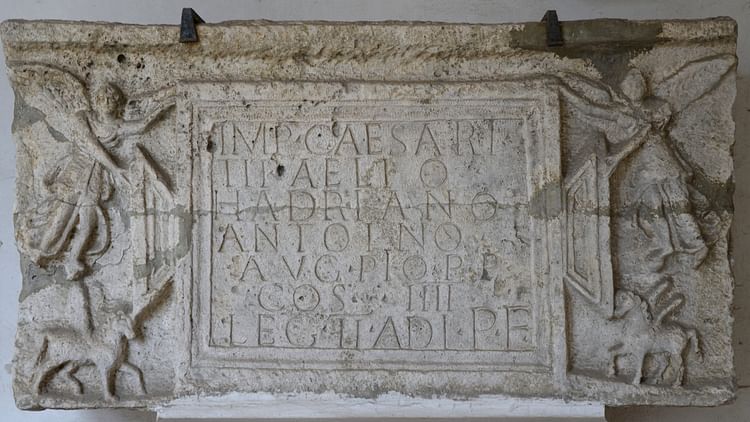
Replaced by Legio XXII Primigenia, the legion left Vetera, and it was with Cerialis in Britain, fighting the Brigantes in 71 CE. Under the leadership of governor Agricola in 84 CE, it campaigned in Scotland and Wales. After returning to the continent, it was part of Domitian's Dacian War against Decebalus and was one of the nine legions victorious at the Battle of Tapae. It was later stationed at Singidunum (modern Belgrade, Serbia) with IV Flavia Felix in Moesia during Trajan's campaign in Dacia. In 106 CE, it was transferred to Aquincum in Pannonia, where it would maintain a base for the remainder of its existence. It served under Hadrian in his Sarmatian campaign in 116 CE and fought with both Lucius Verus in his Parthian war and Marcus Aurelius against the Marcomanni. In 132-135 CE it helped suppress the Bar-Kochba Revolt. The II Adiutrix supported the claims of Septimius Severus to the Rome throne in 193 CE and fought against the claimant Pescennius Niger and well as in Severus' Parthian campaign. There is some evidence it fought with the emperors Caracalla and Gordian III.

